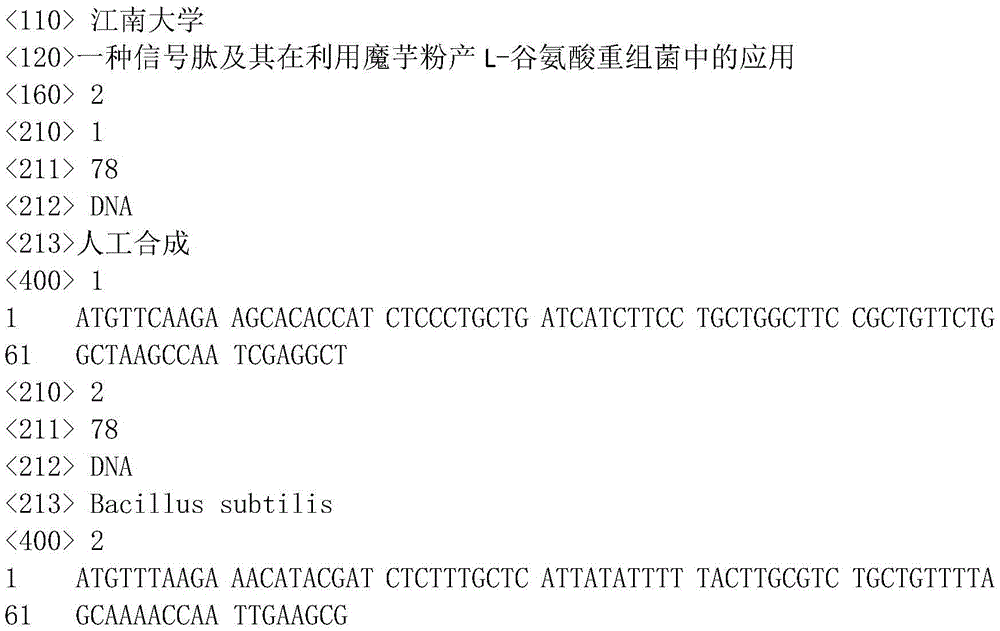Signal peptide and application thereof in recombinant bacteria for producing L-glutamic acid from konjaku flour
A technology of konjac flour and signal peptide, applied in the fields of genetic engineering, protein and enzyme engineering and metabolic engineering, can solve the problem that konjac flour cannot be directly used
- Summary
- Abstract
- Description
- Claims
- Application Information
AI Technical Summary
Problems solved by technology
Method used
Image
Examples
Embodiment 1
[0017] Example 1: Primer Design of Signal Peptide Primer Tandem with β-Mannanase
[0018] According to the relevant gene sequence and β-mannanase gene sequence published on NCBI, the signal peptide and gene tandem large fragment primers were designed.
[0019] P1:pMSPmanHindIIIF
[0020] 5'-CCC AAGCTT ATGTTCAAAGAAGCACACCATCTCCCTGCTGATCATCTTCCTGCTGGCT
[0021] TCCGCTGTTCTGGCTAAGCCAATCGAGGCTCATACTGTGTCGCCTGTGAATC-3’
[0022] P2:pMSPmanBamHIR
[0023] 5'-CGC GGATCC TTACTCAACGATTGGCGTTA-3'
Embodiment 2
[0024] Example 2: β-mannanase gene signal peptide replacement and its cloning
[0025] [1] Chromosome was extracted from B. subtilis CCTCCM209200 as template DNA.
[0026] [2] Design signal peptide and gene tandem PCR primers according to the β-mannanase gene sequence published on the NCBI website. Using the genome of B. subtilisCCTCCM209200 as a template, a β-mannanase gene with a code-optimized nucleotide sequence such as Mannasesignalpeptide (MSP for short) signal peptide shown in SEQ ID NO: 1 was obtained by PCR with large fragment primers. PCR amplification system (50 μL): template 1 μL, upstream and downstream primers 0.5 μL, dNTPMix 4 μL, 10×ExTaqBuffer 5 μL, sterilized ddH2O 38.5 μL, ExTaq DNA polymerase 0.5 μL. PCR reaction conditions: 94°C pre-denaturation, 5min, one cycle; 94°C denaturation, 30s, 56°C annealing, 30s, 72°C extension, 1min30s, 30 cycles; 72°C, 10min, one cycle; 4°C, 10min, one cycle Cycling (in which annealing temperature and extension time are adju...
Embodiment 3
[0027] Embodiment 3: Construction of recombinant plasmid pXMJ19-MSPman
[0028] [1] Construct the recombinant plasmid pMD18-T-MSPman and introduce it into E.coliJM109. The product recovered by PCR in [2] was ligated with the cloning vector pMD18-T. The ligation system was 5 μL of solution I, 4.8 μL of the target gene, and 0.2 μL of the pMD18-T plasmid, and ligated overnight at 16°C. The ligation product was transformed into E.coilJM109, spread on an LB plate containing 100ug / mL ampicillin, cultured overnight at 37°C, picked a single colony into 10mL liquid LB medium containing 100ug / mL ampicillin, and shaken at 37°C After culturing overnight, the plasmid was extracted and named pMD18-T-MSPman. After PCR and restriction enzyme digestion verified that the connection was successful, the bacterial liquid was added to glycerol and stored in a -70°C refrigerator.
[0029] [2] The pMD18-T-MSPman plasmid extracted in [1] and the expression vector pXMJ19 were subjected to double diges...
PUM
 Login to View More
Login to View More Abstract
Description
Claims
Application Information
 Login to View More
Login to View More - R&D
- Intellectual Property
- Life Sciences
- Materials
- Tech Scout
- Unparalleled Data Quality
- Higher Quality Content
- 60% Fewer Hallucinations
Browse by: Latest US Patents, China's latest patents, Technical Efficacy Thesaurus, Application Domain, Technology Topic, Popular Technical Reports.
© 2025 PatSnap. All rights reserved.Legal|Privacy policy|Modern Slavery Act Transparency Statement|Sitemap|About US| Contact US: help@patsnap.com

